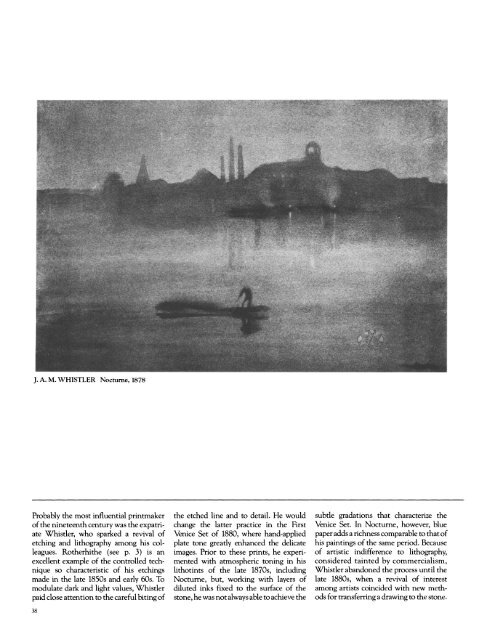The Metropolitan Museum of Art Bulletin, v. 37, no. 4
The Metropolitan Museum of Art Bulletin, v. 37, no. 4
The Metropolitan Museum of Art Bulletin, v. 37, no. 4
You also want an ePaper? Increase the reach of your titles
YUMPU automatically turns print PDFs into web optimized ePapers that Google loves.
J. A. M. WHISTLER Nocturne, 1878<br />
Probably the most influential printmaker<br />
<strong>of</strong> the nineteenth century was the expatriate<br />
Whistler, who sparked a revival <strong>of</strong><br />
etching and lithography among his colleagues.<br />
Rotherhithe (see p. 3) is an<br />
excellent example <strong>of</strong> the controlled technique<br />
so characteristic <strong>of</strong> his etchings<br />
made in the late 1850s and early 60s. To<br />
the etched line and to detail. He would<br />
change the latter practice in the First<br />
Venice Set <strong>of</strong> 1880, where hand-applied<br />
plate tone greatly enhanced the delicate<br />
images. Prior to these prints, he experimented<br />
with atmospheric toning in his<br />
lithotints <strong>of</strong> the late 1870s, including<br />
Nocturne, but, working with layers <strong>of</strong><br />
subtle gradations that characterize the<br />
Venice Set. In Nocturne, however, blue<br />
paper adds a richness comparable to that <strong>of</strong><br />
his paintings <strong>of</strong> the same period. Because<br />
<strong>of</strong> artistic indifference to lithography,<br />
considered tainted by commercialism,<br />
Whistler abandoned the process until the<br />
late 1880s, when a revival <strong>of</strong> interest

















